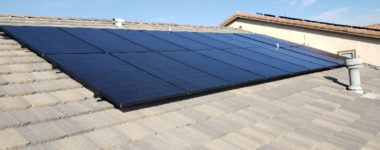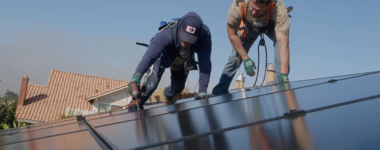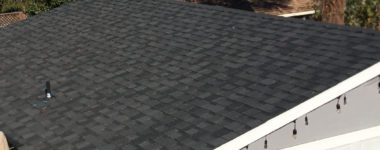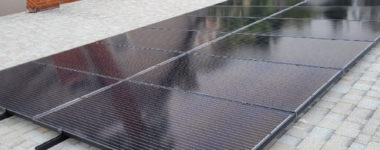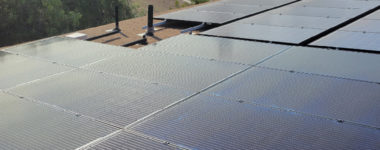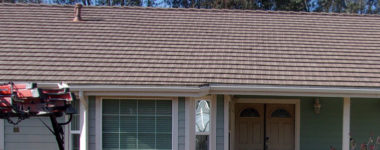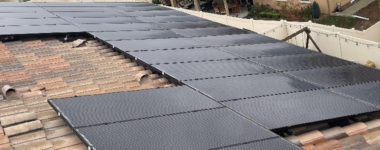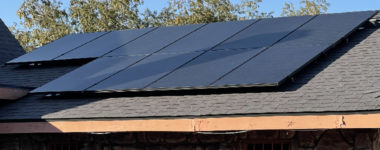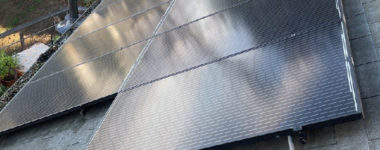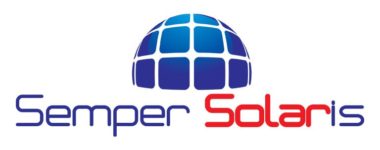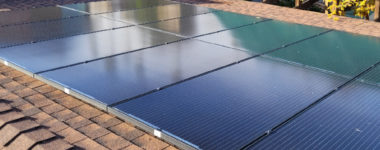Semper Solaris Blog
There is nothing like a beautiful, sunny day in Santa Monica. While there may be a lot of them, we still never grow tired of the consistent sunshine! One of the main reasons? It means we can help our customers continue to harvest the power of the sun for their benefit! With how expensive the electricity bills can be in this community, there is no doubt going solar is a serious attraction. As the fastest-growing solar contractor in Santa Monica, Semper Solaris is ready to help you make your community greener and take maximum advantage of solar savings. While going solar may feel like a big, complicated decision, we like to take the confusion out of the equation. Our goal is to make the solar process and investment as simple as possible for our customers to understand and determine whether it's right for their circumstances. We’ll walk you through each and every step to ensure you are comfortable with it! Learn about our current offers or find out how you can go solar by calling our experts today! Perks of Installing Solar Panels Having solar panels installed on your home can be extremely beneficial. There are countless benefits you’ll reap from this investment -- that includes everything from creating a more eco-friendly home to extra cash back in your pocket every month. Take a look at the wide range of solar benefits below! Real Savings on Long Term Expenses Looking for a way to reduce your energy bills? Having solar panels installed will greatly cut down on your monthly electricity costs. Electric company rates are predicted to have a steady increase throughout the next years, and being dependent on volatile rates and unable to dimish your electric use can be extremely damaging to your personal finances. Renewable energy allows you to break that cycle — to take charge of your energy source, to monitor your energy production, to understand how much you’re using and producing and to adjust your habits accordingly. On top of that, you’re no longer paying for that electricity: what you produce is yours, and whatever is leftover, you sell back to the electric company. No Waiting Period for Savings If you are on the fence about the upfront investment, solar purchase power agreements and leasing options allow you to get more affordable green energy through solar panels right away. You can enjoy all the benefits of solar with a simple “pay-as-you-go” model to take the financial burden off your shoulders and enjoy more immediate savings. A third-party company will actually own the system, but you’ll be able to buy the more affordable solar energy, saving you money month to month. Reasonable Payback Timeline & Cost For those who do want to buy their own solar panel system, the option can be very affordable and reasonable. With all the incentives, rebates, and savings, the payback period is often much quicker than homeowners even realize. This means all their savings on electricity goes right back into their pockets! Boost to Home Value As a prospective homebuyer, seeing that a house has a solar panel system in place can be very appealing. They can step into a smart home that will offer lower electricity bills, ultimately making it a much more attractive purchase. In fact, the National Renewable Energy Laboratory found that homes with solar panels were able to sell not only 17% faster, but for 20% more than comparable homes without panels installed. Numerous Incentives Available The most attractive incentive is no doubt the Federal Solar Tax Credit, which allows you to deduct a percentage of the total cost of your solar panel system (including equipment and solar installation expenses). That automatically takes out a huge chunk of the solar panel system cost! This credit is set to expire soon, however, so make sure you take advantage of it while still available. California is also determined to expand its reputation as a “green” and energy-conscious state, offerings rebates and incentives alongside the Federal Solar Tax Credit and local rebates for Santa Monica residents. Proven Performance & Savings Though they are constantly exposed to the elements, solar panels are designed to be sturdy and long-lasting. Typical solar panel manufacturers stand by their products with extensive warranties, often around 20 to 25 years. These performance guarantees give homeowners peace of mind that their panels are designed to perform exceptionally well for decades to come. And that’s just guaranteed performance, as solar panels are able to last much longer! Protects Environment & Keeps Local Community Green Santa Monica is a beautiful area to live in. Protecting that natural beauty is important, and going solar is one of the ways you can help promote a more sustainable future. It may seem small, but every house and every neighborhood can make a big difference for Southern California in the long run. Renewable energy options like solar panels cut back on air and water pollution that traditional fossil fuels emit. Not only is renewable energy good for the environment, but it's also great for public health, reducing air pollution and protecting precious water supplies. Provides More Energy Independence Electricity costs are currently volatile, with some uncertainty about future expenses to homeowners. That means going solar is more valuable than ever before. Having solar panels allows you to take control back over your electricity costs from utility companies. Even with net metering and time-of-use rates, having solar energy gives you much more peace of mind with your primary electricity use coming from your solar panels or solar credit from your panels. With the always-improving solar battery storage technology, you can further increase your energy independence and decrease reliance on the grid! Why Wait When You Can Start Saving Right Away? Helping the local Santa Monica community doesn’t have to be time-consuming or costly. Going solar can be a great way to help support the environment and your wallet at the same time! The incentives and tax credits still available for homeowners in California make it an ideal time to invest in solar panels. If you are interested in learning more about how installing solar panels in Santa Monica can help you save, add value to your home, and benefit your community, reach out to our team. We can walk you through each and every step of the process and help you select the right panels and system size for your home needs and budget. Semper Solaris is always just a quick call away. Get expert solar guidance today!
There are numerous variables that play into what makes a good solar design. The way a panel is not only installed but designed can greatly impact the productivity of the solar array and the efficiency of the entire solar panel system. That is why it is important to have an experienced solar designer working with you throughout the installation process. The challenge is that homeowners can sometimes have strong preferences about how they want their solar panel system to look with their home design. While they may prefer the panels to be placed a certain way on their roof or layed out according to their vision, a designer can help them not only get the best possible appearance, but also production. Factors Designers Consider So much goes into the actual design of a PV system layout. Designers think through every and factor that can impact a home’s solar energy system. Though your neighbors may look out the window and think the installation process is just a simple step of placing the panels on the roof, the where and how are complicated steps you’ll want to consider with your designer. The main things a solar system designer will calculate and think through: The actual energy usage and demands of the household (watt-hour use per month or year)Estimation of system size and the number of solar panels needed for energy demandsAssess your available roof space and design to determine the best location and layout of panels Factor in any potential challenges such as shading from trees, chimneys, or other structuresWork within your budget and preferences to find the right arrays based on efficiency and output needs An experienced solar designer will take into consideration everything from your past utility bills to the direction of the sun to the type of inverter and arrays you need to maximize your solar investment. Having a designer to the heavy lifting for you means you don’t have to worry about missing any details that could impact solar efficiency for your entire system. With an investment this big, it is crucial that you have your system setup to be as productive as possible to put more savings in your pocket and value back into your home. Get an Experienced Designer on the Job You don’t want just any solar team to install your panels and system -- you want a qualified Inland Empire solar company that uses great products and knows how to come up with a strong solar design. At Semper Solaris, our designers have upwards of 10 years of collective experience and have tackled around 10,000 jobs and counting. We have the knowledge of what makes a truly good and efficient solar system. Our designers ensure our customers have systems setup to produce the best results and benefits their home. By listening to our designers, you can be confident that your new solar panel installation will not only produce but be as cost-effective as possible!
Time for a roof replacement? If your roof has seen better days and you’re tired of placing buckets under leaky spots, getting a new roof can be an exciting process. It’s also a process that can involve numerous steps and obstacles, which is why you want to make sure your project is handled by the best roofing contractor in the Bay Area. Semper Solaris is a qualified and dedicated contractor that handles all types of Roof Installations and replacements, from San Francisco and San Jose to Sacramento City. Our team handles everything from the tear-off to the clean-up, and the thousand steps in between to ensure your repairs or roof replacement are done correctly. After all, your roof is the shield of your home, making it a very important project to be tackled. Steps in the Roofing Installation / Repair Process While not every roofing project will look the same, there are some common steps you can expect to take along the way. Finding a Qualified Contractor Before any work can be done, you need to find the right roofing company to actually handle the job. Every homeowner wants the best for their home, which is why they should do their due diligence and research before settling on a roofing contractor, comparing company values, customer reviews, past project completions, and experience and credentials. You also want to confirm the contractor you are interested in is licensed and insured before starting any work. Getting an Estimate Depending on whether you just need some roofing repairs or a completely new installation, the price could vary. The size of your roof, style, and the extent of your roof’s damage could all impact the final estimate. Another factor that will play a part in the cost of your roof project is the materials involved. Asphalt roofing, on average, tends to be more affordable, though it may need more regular repairs or replacement of shingles. In comparison, a slate or wood shake roof will likely cost more to repair but provides more lasting durability over the course of time. If you are completely replacing your roof, you’ll want to keep these factors in mind, as well as any upgrades you’d like to add to your home down the road. Securing a Permit Now that there is a contractor in place with an estimate you approve of, the final step before any real work can begin is securing the building permit. Speak with your contractor about this responsibility, as some contractors will handle the process for you while others may leave it up to the homeowner to tackle this step. A permit is crucial in order to pass the final code inspection for your roof once the work is fully done. Preparing for the Unexpected As with any construction project, it is important to prepare for the unexpected. For example, in a Roof Installation project there may be significant more damage uncovered throughout the process or a slow down due to weather. Whatever the case, it is important to plan ahead of these types of problems and ensure you have a contingency plan, such as a small budget for additional expenses or costs. While not every project is guaranteed to run into problems, it is better to safely plan ahead! Skill Work Completed on Roof For the homeowner, this is the easy part. Your contractor is in full swing, getting all the skill roofing work done while you sit back and wait for the final results. On average, a roof replacement can take anywhere from a few days to a few weeks. A project can range based on the size of the home, types of materials being used, craftsmanship involved, and unexpected issues and weather. The good news? The contractor you hire should have a team of top-notch roofing experts who’ve handled countless projects before. Debris Clean Up The roof may be down and looking pristine, but the work isn’t quite finished until the final clean up has been tackled. From shingle pieces to stray nails to underlayment, any good contractor will make sure the entire property is looking spick and span and not a single piece of material is left behind. Once this process is done, you can finally sit back and enjoy your new roof. More Questions? Call Our Roofing Experts Today! Getting the ball rolling on a major roof installation project can sometimes be intimidating. That’s why Semper Solaris is here to answer any questions you may have! Whether you want to make sure you have the right material selected or are meeting the specifications to add solar panels down the road, our Bay Area roof installers have the insight you need. Get connected with our roofing team today.
So you’ve already figured out the solar panel advantages of more affordable and renewable energy, but how do you put that cleaner energy to good use? Some people have found extremely creative and innovative solar uses. From charging cell phone batteries on the go to powering outdoor street lights to moving buses, trains, and airplanes along, solar power can go the distance. Residential solar panel systems also offer many advantages, from reducing monthly electricity costs to providing a cleaner way to power additional appliances such as swimming pools. Homeowners can greatly benefit from all the solar uses available to them. Top Innovative Home Uses of Solar Power Solar energy importance cannot be denied -- our environment is in danger of serious negative side effects if fossil fuel use isn’t curbed. Further, our health could greatly depend on cleaner, renewable energy sources like solar. That’s why it is important to put your solar panel produced power to thorough and good use! Some innovative solar energy uses include: Keeping your hot tub perfectly heated Powering your home fans Firing up your cooking appliances Maintaining your thermostat and AC Ensuring your fridge keeps it's cool Warming your household water Ventilating your home with a self contained roof vent fanCharging up all your batteries Lighting your walkways, backyard, and patio While you could opt to have any of these self-contained solar appliances, you could also go fully solar and power your entire home with solar energy in place of traditional grid electricity. Using a converter, the energy will be turned into regular electricity, with any excess sent to your local grid. With this approach, you could even earn credits for any solar panel produced electricity you don’t use. This means all your appliances, from your home water heater to your stovetop could be run off of clean, renewable solar energy. Put Solar Energy to Work for You While having one or two appliances run by solar power can sound like a great cost-saving opportunity, why stop there? With growing solar technology and extended federal tax credits, it has never been more affordable to switch to solar power. We can help you assess your electricity usage and solar panel needs to determine how going solar could save you money. By switching your entire household to solar dependency, you help reduce your footprint and maximize your electricity savings. If you would like more solar energy information, feel free to reach out to our experts at Semper Solaris today.
While fossil fuels are the main source of electricity in the U.S., they are very costly -- both in the financial cost to harvest these fuel sources and the negative impact they are having on our environment. There is no denying that solar will be cheaper in the long run (technically the sun’s energy is free!) and helpful for the environment. While solar panel systems still cost money to develop in order to convert the sun’s energy into usable electricity, it is growing more and more affordable as technology develops. Further, fossil fuels are arguably becoming more and more scarce, as there are limited resources available on our earth. On the other hand, the sun’s power is extremely consistent and unending. By switching over more and more applications to solar energy, we can help reduce our dependence on harmful and waning fossil fuels and protect the long-term health of our environment. Types of Energy Sources Fossil fuels are made up of once living organisms that have taken centuries to break down and transform into their current state. They primarily include carbon and hydrogen bonds. The most common fossil fuels include: CoalNatural GasOil Renewable energy are sources of energy that come from naturally replenishing sources and cleaner processes than modern fossil fuels. The most common types of renewable energy include: Solar PowerWind PowerHydroelectric PowerGeothermal PowerBiomass Power Benefits of Renewable Energy When it comes to solar and other renewable energy sources, there are many benefits. In addition to improving the health of communities, renewable energy greatly impacts the health of the environment. By harnessing the power of the sun, solar provides a source of clean and renewable power, reducing the carbon footprint across California, the U.S., and the entire globe. Fossil fuel burning results in greenhouse gas emissions, pollution of our air, pollution of our water, wildlife and land damage, and other environmental problems. According to a study done by The National Academies of Sciences, Engineering & Medicine, renewable energy options produce much lower greenhouse gas emissions “per unit of electricity produced” compared to how much coal and natural gas plants will produce. However, some renewable energy options like biomass and geothermal can be just as harmful as fossil fuels, which is why more research must be done on these alternative options. Solar and wind power still lead the way in the most clean and growingly affordable renewable sources. In regards to solar, the U.S. Energy Information Administration found that by switching to solar power, an average-sized home in Connecticut (which uses about 8,756 kilowatt-hours of electricity a year) could greatly reduce emissions. Essentially, it was the equivalent to planting 155 new trees -- every year. That is just one small example of what switching to solar and other alternative options could do for our environment. The Bay Area is leading the way in ushering in renewable energy. Interested in learning more about your solar options? Contact Semper Solaris’ today.
Going solar can be a great way to save on electricity bills and add value to your home -- especially when the solar investment tax credit (ITC) offers such an appealing discount. Those considering taking advantage of the massive 30% deduction on the cost of a solar panel system should act fast, however, as the credit won’t last forever. In fact, the first scale back on the credit is slated to happen as soon as 2020. That means 2019 is the last year to take advantage of the full federal tax credit along with any California solar tax credits. Timeline for the Investment Tax Credit While some people may not like that there will be major cuts into the federal investment tax credit for solar panel systems, it is important to remember the original establishment of the credit. When the Energy Policy Act that included the ITC was enacted in 2005, it was only slated to last for two years. Numerous extensions resulted in the credit remaining effective through 2016. Even though those extensions were set to expire, many solar and energy experts pushed for an additional extension of five years to allow for the solar industry to grow even more. In 2015, Congress passed a bill that extended the credit all the way through 2021, with some adjustments year to year. Here is the timeline for extended federal tax credit: 2007 - 2016 The first extension on the ITC pushed it through 2016, maintaining the original 30% tax deduction for homeowners as soon as their system was operational. 2016 - 2019 Additional extension pushed through, preserving the 30% deduction based on the entire cost of the solar panel system, allowing for optimal discounts for homeowners. 2020 Any new solar panel system installed after 12/31/2019 will only be eligible for a tax deduction of 26% of the installation expenses. 2021 After 12/31/2020, homeowners and commercial property owners will only be able to deduct 22% of the solar system costs from taxes. 2022 - Onward The new tax credit rate for commercial solar systems will be 10%, while homeowners will no longer be offered any federal tax credit for new systems installed. Keep in mind, newer legislation enables solar energy system owners to claim the tax credit even if the system isn’t fully operational -- so long as construction is completed. The only requirement is that the system be up and running by 2023. Will I Be Eligible for the Tax Credit? Any homeowner who has installed and owns their solar panel system will remain eligible for the full 30% tax credit through 2019 and any subsequent credits the years following.Just make sure to file IRS Form 5695. What if you are not going to have enough tax liability to even claim the full credit? The credit can be split between years, rolling into the next years for as long as the credit is still in effect. Ready to take advantage of the federal solar investment tax credit before it gets cut back? Semper Solaris can help you get the ball rolling. Reach out today.
Whether you are considering going solar but aren’t sure if your roof could handle the panels or you are just curious about the lifespan of your roof, taking the time to assess your home exterior is important. Not everyone is a roof expert, however, there are some tell tale signs that can give you insight into your roof’s health. We’ve outlined what you should keep an eye out for below. When Is it Time for a New Roof? As a homeowner, there are countless features of your home that you have to maintain, from the plumbing to the landscaping. Your roof condition is one of the most important aspects you can maintain, serving as the protection for your home interior from the outside elements. Here are some of the most common factors that indicate it's time to think about roof for your home: Roof Age Exceeding 20 Years Bald Spots Curling & Buckling Missing Shingles or Materials Roof Valleys Chimney Flashing Granules in the Gutters Leaks in Interior Storm Damage Mold or Algae Cracked Shingles Even if your roof hasn’t experienced major leaks or other problems, it still may be at the end of it's lifespan. Constant preventative maintenance to keep your roof healthy could cost you just as much as a roof replacement down the road, if not more in the long run due to unexpected repairs. The sooner you check off the new roof on your list of home improvements, the sooner you can enjoy peace of mind again. Take the Next Step for Your Roof & Find the Right Contractor You deserve a roof that provides your house with proper protection, insulation, and increased home value. Finding the right contractor is a key step in the process, as they’ll walk you through each step with complete security. The right contractor will also provide you with clear expectations, including an estimated timeline so that you can plan your schedule accordingly. Think your roof is ready for a serious facelift? It’s time to consider your options. If you are looking for expert roof information, Semper Solaris is always just a phone call away. We provide top quality roof replacements that allow homes to adapt to the latest residential solar panel systems. Backed by our military-mindset, we make sure every job gets done with exceptional craftsmanship, work ethic, and integrity. Our Inland Empire roofers can review all your roofing choices, ensuring you understand the best materials needed to upgrade your home with.
While current solar technology is still fairly new, the power of the sun is no modern revelation. The sun is the most powerful and consistent source of energy available to humans. The first solar device to produce a notable amount of electricity was created in 1954 at Bell Labs. Just several years later, the technology was being used in a few select projects, but would soon explode in interested by the 1970s due to current energy concerns. Unfortunately, the high price of PV production prevented more large-scale use of solar technology. Thanks to significant research and developments, modern solar technology is becoming more and more affordable for average homeowners and businesses across the globe. What You Need to Know About Photovoltaic Technology So what does modern solar technology look like today? Photovoltaic, or PV, devices harness sunlight and turn it into electricity. The key? The materials used to make solar arrays or panels are natural semiconductors. When the electrons in them are struck by photons (energy of the sun), they are freed up from their atomic bonds, allowing them to travel through an electrical circuit to provide useable electricity. This can then be used to power electronic devices or sent to a local electricity grid. Essentially, the uses of solar energy can reach beyond just a single home and stretch out to an entire community, even if some of the homes in that area don’t have solar panels. From homes to commercial businesses, solar panels can power both personal devices and large-scale facilities. Common Types of PVs Crystalline silicon (c-Si) - Accounting for about 90% of the globe’s PVs, c-Si is extremely popular due to it's durability and efficiency. Other variations include monocrystalline, polycrystalline and string ribbon PVs. Thin-film PV - Though less efficient than traditional c-Si arrays, these panels are more affordable to produce, thus creating a fast-growing market for cheaper priced solar panel systems. Concentrating PV - These panels are typically seen in vast desert areas, utilizing lenses and mirrors to reflect the power of the sun in a more concentrated manner onto highly efficient cells.Multi-junction / tandem cells - These specialized solar cells are typically reserved for specific projects that require lightweight material and extremely efficient production, making them a prime choice for satellites and military uses. Where PV Technology Is Going While having a solar panel system installed on a home seemed like a great luxury a decade ago, the dropping cost of PV has made solar more and more accessible to homeowners across the U.S. The industry has seen a great demand for more sustainable and renewable energy options, driving up manufacturing and pushing for improved technology and more efficient materials. Though the U.S. is the fourth largest market for PV installations, it is still behind other smaller countries that aren’t as dependent on fossil fuels. The more the U.S. and other major countries adopt this technology, the more it is likely to develop. Questions? Reach out to our Orange County solar company for helpful answers.
As solar technology continues to improve and sustainable energy options become more and more accessible, homeowners across California and the U.S. are beginning to line up to switch to solar. The great news about going solar in San Diego? Homeowners don’t also have to have the savings to cover all the upfront expenses of installing a solar panel system. That means all the benefits of switching to solar are available without the initial heavy financial burden. For homeowners that don’t want to purchase their solar panels and system from day one, there are two main alternatives: solar leases and solar PPA agreements. Under a solar PPA, a homeowner purchases the electricity produced by the solar panels installed on their home (still owned by the solar company) at an agreed upon rate. They basically only get the immediate benefits of more affordable and sustainable energy. While PPA agreements can be attractive to some, others may prefer more flexibility that general leases offer. Under a solar lease, the homeowner still doesn’t own the solar panels or other equipment installed on their home, however, they still have the same net metering process as solar owners would. Generally speaking, the monthly savings homeowners get on their electricity bill will exceed the monthly lease payment, resulting in instant savings. Over the lifetime of a system, a homeowner can see as much as 70% savings on their electricity expenses. What’s the Best Leasing Option for Your Home? When it comes to going solar, you have to make sure you settle on the right lease agreement. So what are your options? Here are some of the most common solar lease agreements: Zero-down: Under this agreement, there is no payment required on the date of signing the lease agreement. Only when the solar panels begin to produce electricity will you begin to pay a monthly fee to the solar panel owners. The benefit is obviously that there is no upfront investment needed and can allow you to get electricity rates that are 20 to 30% lower than average. Each year may include a rate increase.Prepaid: The entire lease is paid upfront, which means you won’t have to make any monthly payments for the duration of the agreement. Essentially, by paying 100% upfront, you get more flexibility with your lease terms because the solar panel owner doesn’t have to assume any risk. You may also get some piece of any Solar Renewable Energy Credits and boost the value of your home by covering the entire lease upfront. By opting for a lease, the total price of the system is typically between 30% and 50% cheaper than it would have been without a third-party owner.Custom down-payment: With this type of agreement, you can expect to pay some amount upon the initial signing, usually negotiated with the third-party owner. The down payment may range anywhere from $1,000 to $5,000, allowing for lower monthly payments. Typically, a down payment will negate the annual rate increase a $0-down lease includes. Make the Right Solar Choice With so many options for going solar, it can be overwhelming to make decisions on everything from type of solar arrays to financial agreements. That’s why Semper Solaris is here to provide the guidance and insight you need on solar financing. Over the years, our San Diego solar company has installed thousands of residential solar projects. Time and time again, we’ve helped homeowners select the right solar agreement for their financial situation. When you work with our team, we’ll review your budget and preferences and help you select the best solar leasing option. Interested in learning more? Give Semper Solaris a call anytime to get connected with a solar expert!
California is one of the leaders in renewable energy resources. While the rest of the country is following suit, not every state or city is as passionate about solar and other renewable energy sources. This means that not every homeowner across the country would necessarily add property value by installing solar panels on their home. The good news? The Bay Area is one of the most popular areas for solar panels. Whether you live in Sacramento City or San Francisco, having solar panels could be a great investment if you are looking to add value to your home. How Going Solar Can Benefit Your Property Value Sure, you’ve heard that adding solar panels can be a great boost for a home, but does it really add any property value? According to a study done by Berkeley Lab, potential homeowners have been showing a willingness to pay a higher price tag (floating around $15,000 or more depending on the size of the system) for a house with an adequate solar panel system. While buying a solar system is a big investment, the savings on utilities, reduced carbon footprint, and added monetary value to a home make it an attractive upgrade. Just like a remodeling kitchen or backyard addition, solar panels are seen by potential home buyers as a distinguishing factor on the market. In fact, in a past study, homes in California that had energy efficient features, such as solar arrays, were actually found to sell faster than those that were not as efficient. Some factors can impact the solar value added to your Bay Area home: The production and quality of your PV panels (i.e. how much sun they get and brand name) The size of your solar installation compared to the size of your home The overall energy efficiency of your home Whether you own the system outright or are leasing it The starting value of your home and current market price It is important to note that just leasing a solar panel system will likely not add value to your home at all. On top of that, it can be difficult to transfer the lease to a potential buyer, so make sure to consider your financial situation and options when it comes to your solar investment. Deciding if Solar Panels Are Right for Your Home If you are simply looking for a way to add value to your property for a quick sell, solar panels won’t necessarily be the simplest or even most beneficial option. However, if you are planning to invest in solar panels so that you can reap the benefits of saving on your utility expenses and have your panels paid off or significantly covered, going solar could bring a nice boost to your property value. Down the road, if you decided to sell your home, you could expect to benefit from having solar panels already installed. Still have questions about the value solar can bring to your home? Semper Solaris is here to provide more insight. Give our experts a call today to learn more.
So you’ve thought about some of the benefits of going solar and want to find out what to expect in the process. Whether you are in Antelope Valley or Downtown Los Angeles, having the right solar company tackle your installation is key. Semper Solaris is here to provide a breakdown of the solar installation steps you can expect. What Is Involved in the Solar Process? We know that it can be slightly overwhelming trying to navigate all the solar steps on your own. That’s why we’ve created a quick guide on what to expect below. Get quotes from local companies - Find the right fit isn’t always easy, but it is likely the most important step in the whole process. You want a company that is reliable, fair, honest, and highly skilled at what they do. Read reviews, ask around, read about their values, and request a quote before making any decisions. The right company will help you calculate your solar needs and quote you on a system size according to those demands. Decide on an installer and payment plan - Once you’ve decided who you are going with, you can work with them to figure out which financial path is best for you. Your options range from a lease agreement to a PPA to financing to loaning to putting cash down for a outright ownership of the system. Discuss these options with your installer to ensure you choose the best one for your financial situation. Solar inspection - The next step is getting your selected solar installer to perform an inspection, which happens before any solar work can be done to your home. You’ll need to have your home evaluated for your desired solar panel system. These means that your electric panel and breakers will be inspected to ensure that they can handle the installation planned -- or add on an upgrade if necessary. During the inspection, your solar company will also help you decide on where to have the panels installed on the roof and have it inspected for structural integrity to ensure it can handle all the necessary equipment. Solar permitting - While the actual installation of a solar system could be completed quicker, the entire process can take anywhere from a few days to 8 weeks or even longer in some cases due to the permitting and approvals that need to be received before any work and solar production can actually begin. The good news? Your solar contractor will work on getting most of the permits and paperwork you need taken care of on your behalf; this includes helping you sign up for tax credits, rebates, and local incentives. Having the equipment installed - Once the permits are cleared and the equipment arrives, the physical installation will begin. Your roof will be made secure with racking equipment for the panels and any other support or small repairs needed. During this process, your installer (or possibly the utility company) may need to have an upgraded power meter installed to allow for bi-directional electricity metering so that net metering is possible. Wiring will be installed and connected to the solar panels and inverter / power controllers. Final inspection before being powered on - Once all the equipment is installed and functioning properly, there is one final step: interconnection and approval from your utility company or city inspector. The inspector has to ensure that the installation was done correctly, safely, and completely up to code. After it's been signed off, the switch can officially be turned on and your solar panels can get to work producing electricity. Get Your Solar Journey Started Today Ready to get the ball rolling on your solar installation process? The Los Angeles solar installers at Semper Solaris are always ready to help. We’ve worked with countless customers throughout the L.A. area, installing solar panels on houses big and small alike. With a team of highly skilled professionals -- many of which are veterans thanks to our military roots -- we are more than equipped to tackle your solar project for you. Working with us means quality service, caring support, and unmatched work ethic and integrity. Learn more about the Semper Solaris solar panel installation process by contacting us today!
Going solar is a major step towards a more sustainable energy source and monthly utility savings. For many homeowners, adding solar panels to their property provides major savings and improves the value of their home. With net metering, you are also able to get credits per kWh of electricity your solar panels produce. These credits go directly towards your energy bill, cutting back on your costs. So what happens when your solar panels go above and beyond, producing and sending even more electricity to the grid than your entire household uses any given month? While it would be ideal if selling energy to your own utility company was possible, that currently isn’t an option available here in California. However, the average household solar panel system doesn’t typically generate enough unused electricity to actually create a profit from selling that extra energy to their companies. While energy-consciousness or smaller households may be able to cover all utility expenses with their solar panel systems, most consumers are aiming more realistically to majorly cut down their monthly costs rather than eliminate them (you would need a very large system for this). What's The ROI on Solar Panels? ROI solar panels refer to the return on investment (ROI) that your solar panel systems provide by generating electricity from sunlight. You can determine the ROI by calculating the amount you save on your energy bills and any income you receive through solar buyback programs. What Is Solar Buyback? Solar buyback is a program that allows individuals or businesses who generate excess electricity from their solar panels to sell it back to the grid or their utility company. It is also known as net metering or feed-in tariff (FIT). You may receive cash or credit towards future energy bills. Capitalizing on Your Solar Investment According to statistics, the average American family has to fork out more than $1,430 a year for their electricity expenses alone. On top of that, the cost of electricity has risen by 2.2% per year across the nation. With the threat of continual spikes in energy prices and the burden of more harmful energy resources on our planet, investing in solar probably seems like a very attractive option. Even though you won’t necessarily be able to earn extra money from your solar panels, you can make your investment worthwhile by capitalizing on all the savings and solar rebates available to you. Some of the ways you can save big on solar: 30% federal tax credit Zero dollars down until 2020 Various local incentives Cutting back on monthly utility expenses Increased home value> The Investment Tax Credit is obviously the most appealing solar credit to homeowners. You are able to claim 30% of the home solar panel system price through a tax credit. Even if you don’t have enough tax credit to claim the whole credit for one year, you can roll it over into the next year. Find Out How You Can Save With Solar With the cost of electricity continuing to rise, now is the time to start thinking seriously about how creating a solar profit. For an average household and solar panel system size in California (6-kilowatt system), homeowners meeting above 90% of their energy needs can expect to save around $13,000 over the first 6 years and around $29,420 by the 20-year mark. p>Though savings can vary based on energy demands, electricity rate fluctuation, and various other factors, the savings available through going solar are very real. Interested in learning more? Our Los Angeles solar installers would love to give you more information.
What Is Net Metering? Solar panel systems are designed to provide cleaner and more affordable energy to homeowners. So what are ways homeowners can save even more? Net metering is one of the most appealing aspects of going solar in California. Why? Because net metering allows homeowners to receive bill credits back on any additional electricity produced by their solar panels. Essentially, any energy their panels produce that isn’t used up by their household demands is able to be funneled back to them as a credit for low production times or surplus. There have been some slight changes to the original net metering policy for California. The original net metering allowed a bill credit for one kilowatt-hour (kWh) of electricity for every kWh your solar panels produced and fed to your local grid. Any excess amount would be applied to the times when you had to draw upon the grid instead of the solar power grid. With net metering 2.0, the core of the original policy remains the same – essentially credits are still equivalent. The new policy also helps prevent grid access charges, capacity fees, and other charges that don’t favor homeowners. However, the three new features – time-of-use rates, interconnection fees, and non-bypassable charges – do add some expense for homeowners. California Solar Energy Industries Association estimates expenses will increase by around $10 a month for the average homeowner. How Net Metering Can Still Save You Money Over the lifetime of a solar system, a homeowner could save thousands of dollars in electricity expenses through net metering. If your solar panels are able to produce a significant enough amount, you could end up having the majority of your bill covered, if not entirely covered. For example, say you have to draw 800 kWh of electricity from the grid throughout the month of November during the times when your solar panels aren’t producing electricity (on those cloudier days). If you are able to export 600 kWh of energy throughout the course of the same month, you could cover a majority of your bill, only being charged for the net difference of 200 kWh. Again, some months your solar panels may be able to produce an equal amount to completely cover your usage needs, especially during those sunnier months. Understanding Time-of-Use Rates So what are time-of-use rates and how will they impact you? Under net metering 2.0, time-of-use billing is used to charge customers more for peak hour usage and less for off times. Under the solar billing cycle, you could greatly benefit because your solar system will typically generate more power during peak hours (or more expensive windows) depending on your area. That means you can avoid the higher charges and have more credits stored up for when you need to use them during low production hours (ideally off-peak times so they go further). Unfortunately, this could also mean that if you use a lot of energy in the early evening and your panels don’t produce much energy during this time of day, you could be paying more than you previously did. The best bet? Review your net metering time-of-use rates and adjust to the peak and off-peak hours to ensure you maximize your savings. More questions about net metering? Let the Semper Solaris experts provide insight. Call us today to speak to a solar professional in San Diego.
PPA vs. Lease: What’s Right for Solar? When it comes to getting a solar panel system installed on your roof, there are many decisions to be made – including tough financial decisions. For some homeowners, the ability to finance a system may not be possible. This is where solar leases and Power Purchase Agreements (PPAs) come into play. These are two options available to homeowners who are looking to save on their electricity bills by switching to solar without carrying the full financial burden of financing or paying off their own solar system. Under both a solar lease and solar PPA, the homeowner themselves will not own the actual solar energy installation placed onto their roof. Instead, a PPA or lease company has true ownership over the system. While very similar, PPAs and leases have some very distinct differences between them. Selecting the right one for your project is important! Breaking Down Your Solar Options Solar leases – Under this type of agreement, a homeowner doesn’t own any of the equipment installed on their roof or connected to their home. They will still have the same interaction with their utility company in terms of buying and selling electricity (i.e. net metering), just as someone who actually owned their solar panels would. A homeowner can expect to pay monthly rent throughout the terms of the agreement, which can range from around 20 to 25 years. Solar PPAs – Under this type of agreement, the homeowner doesn’t own the equipment or even make any leasing payments. Instead, the PPA company comes in and installs their solar panel system on the house and actually sells the homeowner the electricity produced by the panels for a negotiated rate. With a PPA, the homeowner can either opt to pay for only the electricity they actually end up using or a fixed monthly amount, depending on the agreement details. Similarly to a lease, the agreements tend to run up to 25 years. The specifics of the agreements can vary based on homeowner preference. For example, a contractor may offer zero down, free installation, a down payment, prepaid leases, varying kW sizes, and other factors. Make the Best Solar Choice for Your Needs So what’s the better option, a solar lease or PPA? At the end of the day, it comes down to what makes the most sense for your particular situation. You may prefer to not have a lease payment and be able to negotiate on the pricing of your electricity with a PPA or like the flexibility of leasing panels while buying / selling the electricity produced by it. The last option available to homeowners is financing or paying cash. For those that are able to, this is the most financially beneficial, as the homeowner will typically be able to pay offer the system in 12 or less years. Still, both solar leases and PPA agreement are viable options for those that want to benefit from the perks of solar without all the upfront costs. Still interested in learning more about your different solar payment options in San Diego? Semper Solaris is here to provide insight. Schedule your free energy analysis now!
Is Your Roof Equipped for Solar Panels in San Diego? Solar panels can be installed on most properties in the county, from Pomona to Imperial Beach, but the state of your roof will have a big impact on the ease of the job. The shape, size, and even the direction your rooftop faces will inform the advice you get from your solar provider and the bid you receive. A lot of Southern California roofs have signature clay tiles in keeping with a Spanish aesthetic, but your San Diego home may have asphalt, slate or other materials on top. Before you start shopping for solar panels, get a consultation from a San Diego roofing company. A professional team will be able to point out any potential obstacles to solar on your roof and construct a creative workaround. At the end of the day, with some planning and perseverance nearly any San Diego roof can turn our 266 annual days of sunshine into a renewable energy source. Deal with Obstacles on Your Roof The first and most obvious thing to check on your roof is the presence of clear obstacles to a panel installation. Do you have a chimney, skylights, vents, or a television satellite that could get in the way? Some things, like a chimney, can’t be moved to accommodate solar panels. Other issues, such as a tall neighboring shade tree, can be altered to make room for your new solar system. If you have limited roof space due to skylights and other obstacles you may want to go with more efficient solar panels, which tend to be smaller. In any case, it’s vital to have an inspection of your roof to identify any obstacles so that you and your solar provider can create a game plan and order the appropriate materials from the start. Eliminating as much shade as possible is important to yielding full power from your panels. Talk About Roof Shape with Your Provider Most homeowners don’t take the time to learn it, but your roof shape has a name. There are three main types of roofs: hip, gable, and flat. Some roof types are more conducive to using solar panels than others, but a good solar provider will take your roof shape and make it work. Each type has its own pros and cons: Hip Roof: A hip roof is a style in which the roof slopes on all four sides and create a tall peak at the top. The slopes work in favor of solar panels, because they provide the necessary tilt, but the surfaces can be on the small side depending on the design of your home. These roofs can also have an unusual shape with some unusable surface area. Gable Roof: A gable roof is sometimes called a peak or pitch roof, and it has two sloping sides that meet in the middle to create a triangle shape. Solar panels typically have plenty of surface area to work with on a gable roof. These roofs also shed water easily, so your panels will never experience pooling water underneath. Flat Roof: Flat roofs are common on some home types in San Diego -- primarily condo complexes. While solar panels don’t work best when installed flat, your provider can use tilts to position solar panels at an advantageous angle on a flat roof. You shouldn’t rule out solar if you are working with a flat surface area. Use a Solar-Friendly Material for Your San Diego Roofing Some roofing materials are better for solar panels than others. Fortunately, the most commonly used roofing materials in San Diego are ideal for solar panel installations. The only shingles and tiles to avoid are brittle materials like wood and slate, which can easily break while affixing solar panels. Your solar provider will advise you about whether or not your roof is currently covered in a surface that is compatible with solar panels. Spanish Clay: Spanish clay tiles are great for solar panels. They’re also everywhere you look in San Diego County. Standard mounts can penetrate this type of tile, so they’re a good choice for a home that goes solar. Many installers can even create a special mount built into clay to make adding solar panels even easier. Asphalt: A roof with asphalt (often a flat roof) can also work with solar panels. A standard panel mount will easily attach to an asphalt rooftop. Asphalt/composite shingles are also quite popular on slanted rooftops, and you shouldn’t have an issue adding panels to these shingles. Metal with Standing Seam: Metal roofs with a standing seam are very friendly to solar installation. In many cases the panels can be clamped to the seams so providers don’t have to attach the panels to the metal roof itself. Fix Bad Tiles and Other Roof Problems If your roof is old, it may not be ready for solar panels just yet. Imagine investing thousands of dollars in a solar setup, only to have your roof reach the end of its life within two years: You would have to remove the solar panels to fix or replace your roof and then install them all over again. It’s better to ensure that your roof and solar panels have a similar life cycle whenever possible. A good rule of thumb is that any roof more than 10 years old could need repairs or replacement prior to going solar. The good news is that Spanish tiles could last on your San Diego roof for up to 50 years, and new solar panels could last for about 40 years. If you get a roof replacement and solar installation now, you’re probably set for your entire ownership of the property. Aside from broken tiles and leaks, you should also address any punctures and penetrations, issues with ponding water, and cracked flashing. Orient Solar Panels For Maximum Sun Exposure The best direction for solar panels to face is true south. If that’s not possible, southeast and southwest orientations can still yield excellent and reliable solar power. You can also position your solar panels facing east or west, but you may not be able to enjoy the full potential of your renewable energy. While you can’t rotate your home, there may be some things you can do to prepare your roof for solar panels so they face the best possible direction. As mentioned previously, installers can install a stand that tilts the panels. This may help a panel on an eastern roof point closer to the southeast. You could also to remove obstacles on a south facing part of your roof to make room for the panels. Make Sure You Have Enough Space for Solar Panels It would be a shame to get your heart set on a brand new set of solar panels only to discover that you just don’t have the square footage on your roof. As a general rule, for every Kw of solar generated for your home, you need 100 square feet of roof space. Most homes can thrive with a 5Kw system. If an original assessment determines you don’t have enough space for solar panels, you have a few options. You can get a smaller system and rely partially on regular grid power, consider covering a skylight or addressing other obstacles, or look into installing ground-mounted solar panels. Installing solar panels in your yard isn’t as common as using roof-mounted setups, but if you have the property to spare it could solve a lot of issues. Ground panels can not only compensate for a lack of adequate roofing, they also help if you have too much shade on your roof that can’t be changed (such as from a tall building next door). Ready to update your San Diego roofing with some shiny solar panels? You’re not alone! Becoming energy independent is more and more popular in the Golden State. In fact, most new-build homes will be powered by solar beginning in 2020. Get ahead of the trend by installing solar now (and taking advantage of one of the last years for the Solar Investment Tax Credit). Contact Semper Solaris today to learn more about getting solar panels in San Diego. You can receive a no-pressure bid, and our experienced team will talk to you about the state of your roof along with the potential of solar. We are also ready to help you with a roof replacement if you need it!
